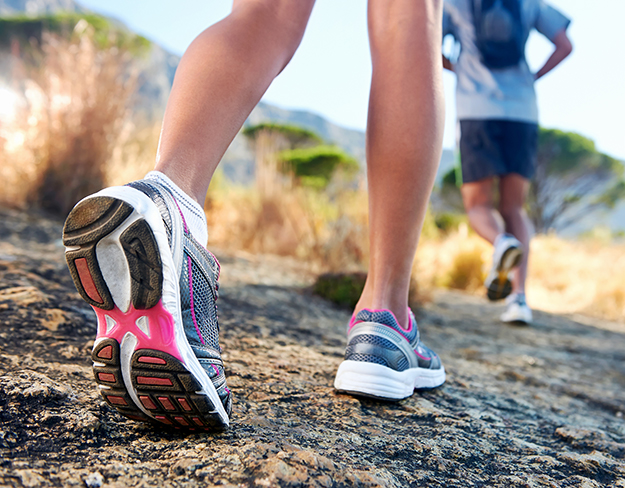

What is it?
Athlete’s Foot, medically known as tinea pedis, is due to fungal infection. It usually affects the area between the 4th and 5th toe. The condition is estimated to affect 3-15% of the population, with men and the elderly more likely to contract the infection [1]. Up to 15% to 25% of people are expected to develop Athlete’s Foot at some point during their lifetime [2]. The fungus causes the skin between the toes to become white and damp. As the condition develops, the affected area becomes dry, scaly and itchy before turning red, thick and swollen.
The infection has the ability to spread throughout the sole of the foot. The skin of the heel, fringe of the sole and inside of the arch may then become, flaky, tight and itchy. In some cases, the condition can become severe and result in Moccasin Athlete’s Foot where it can be mistaken for other skin conditions (e.g. Eczema). In extreme cases, the infection can cause inflammation resulting in blisters, fissures and open sores forming on the soles of the feet.
The same type of fungi is also responsible for toenail fungal infections. Toenail infections can therefore develop into Athlete’s Foot or vice-versa. The condition can also spread to the fingernails, groin and underarms.
What causes it?
Athlete’s Foot is caused by fungi (dermatophytes) which penetrate the outer layer of skin through cuts or small cracks, infecting the foot. The condition is acquired when an infected piece of skin comes in contact with a healthy foot.[1]
Similar to toenail fungal infections, the fungi thrive in warm and damp environments. Wearing shoes provides the perfect habitat for the fungi, whilst the outer layer of our feet provides the protein – Keratin, which the fungi feed on.
There are many factors that can increase the risk of developing an Athlete’s Foot. The condition gets its name as it commonly develops in particularly sweaty feet, often as a result of running or playing sport. Poor foot hygiene, wearing restrictive boots or shoes, swimming in public pools or using communal showers are risk factors. Research has further suggested that a genetic predisposition may play a role in infection. If members of your family have it, you’re more likely to get it, too. A parent may pass the infection to his or her children, but the spouse may not be affected. This shows the genetic predisposition.
Poor circulation in the legs (potentially caused by diabetes or shrunken blood vessels) and a weak immune system (due to illness or age) are additional risk factors. Pre-existing skin conditions such as Eczema may predispose one to develop Athlete’s Foot.
How is it treated?
Prevention
Improved foot hygiene, including airing your shoes and washing socks, hosiery and bedding often, has been highlighted as an effective prevention technique. Keeping the foot dry and clean is important for preventing the condition.
Topical Creams & Remedies
Effective treatment products including topical creams, sprays and gels are readily available from pharmacies. The most usual form of treatment for tinea pedis is the application of topical antifungal cream. Although usual treatment plans last around 4 weeks, fungal infections can be difficult to treat and can sometimes become chronic. Topical creams are effective and have been found to have superior results when compared to placebo [3].
Herbal foot baths and tea tree extract are frequently recommended as home remedies. However, these home treatments are not backed by scientific research.
Medication
In more serious cases, when other treatment methods have failed, tablet medication may be prescribed, for instance, fluconazole and Itraconazole. However, both of these medications can have adverse side effects, including stomach upset and diarrhea.
more recommended stories
 Safer Allogeneic Stem Cell Transplants with Treg Therapy
Safer Allogeneic Stem Cell Transplants with Treg TherapyA new preclinical study from the.
 Autoimmune Disorders: ADA2 as a Therapeutic Target
Autoimmune Disorders: ADA2 as a Therapeutic TargetAdenosine deaminase 2 (ADA2) has emerged.
 Kaempferol: A Breakthrough in Allergy Management
Kaempferol: A Breakthrough in Allergy ManagementKaempferol, a dietary flavonoid found in.
 Early Milk Cereal Drinks May Spur Infant Weight Gain
Early Milk Cereal Drinks May Spur Infant Weight GainNew research published in Acta Paediatrica.
 TaVNS: A Breakthrough for Chronic Insomnia Treatment
TaVNS: A Breakthrough for Chronic Insomnia TreatmentA recent study conducted by the.
 First-of-Its-Kind Gene-Edited Pig Kidney: Towana’s New Life
First-of-Its-Kind Gene-Edited Pig Kidney: Towana’s New LifeSurgeons at NYU Langone Health have.
 Just-in-Time Training Improves Success & Patient Safety
Just-in-Time Training Improves Success & Patient SafetyA study published in The BMJ.
 ChatGPT Excels in Medical Summaries, Lacks Field-Specific Relevance
ChatGPT Excels in Medical Summaries, Lacks Field-Specific RelevanceIn a recent study published in.
 Study finds automated decision minimizes high-risk medicine combinations in ICU patients
Study finds automated decision minimizes high-risk medicine combinations in ICU patientsA multicenter study coordinated by Amsterdam.
 Study Discovers Connection Between Omicron Infection and Brain Structure Changes in Men
Study Discovers Connection Between Omicron Infection and Brain Structure Changes in MenA recent study in the JAMA.

Leave a Comment